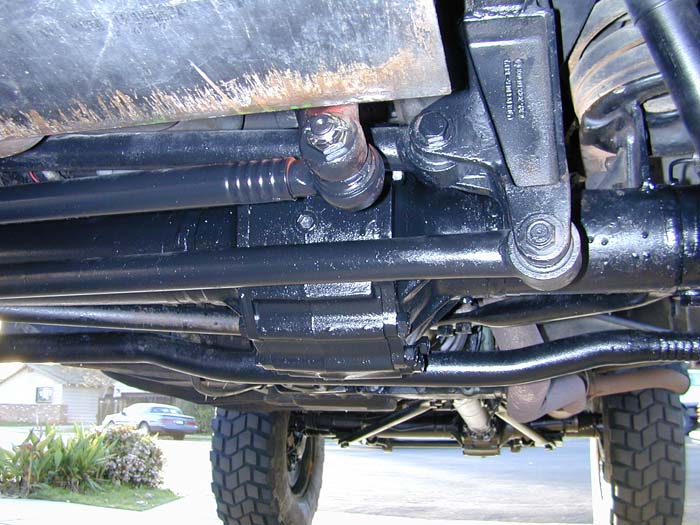U1300L Axle Rebulid
Making something good even better
Feburary, 2000
Back to Bill Caid's Home Page.
The Event
When I bought my Unimog model 1300L, it had had a hard life. My unit was not an ex-military truck, but rather had seen civilian service as an off road cargo hauler (explosives and seismophones for a geophysical exploration company). One of the previous owners, of which there were at least 3, "submarined" the truck and got water in the portal axels and drive line. After sitting for extended periods, the rust finally took it's toll. Eventually, the wear and rust pitting got so bad that the truck would grind as you drove it at low speed. Of course, you could only hear it at low speed due to the tire noise. The damage was building and eventually, it would have to be replaced. One other issue bothered me and that was the truck's inability to hit 60 mph due to low gearing. The plan was to kill 2 birds with one stone. Master mechanic Kai Serrano would replace the ring and pinon gears and we would replace them with a higher ratio, thereby giving me additional top end. It was a good plan, although the gear sets were viciously expensive ($3K a pair or something obscene like that). And of course, you need new bearings, seals, etc so the actual price was much, much higher. The photos below describe the process of changing the gears and detail the intense damage that was present in the rear gear set..

Removing the wheel hub and draining the oil in the hub.

Separating the axle/torque tube assembly from the transmission.

Torque tube housing separated from the transmission housing. Note joint in center.

Kai removes drive shaft from torque tube with pan to catch oilt.

Unit fully separated from truck.

Note the severe scarring on the pinion. These were deep.

The oil had turned to peanut butter, probably from the heat of friction.

Looking into differential pumpkin: note scarring on the gear faces.

Dirty, damaged parts. The whole thing is hosed.

Trying to remove the grease from the parts, it was so thick you had to chip it off.

Inside the gear housing, more peanut butter.

New ring and pinion. These are a matched set.

Note damaged inside housing from wearing gears.

Old versus new spide gears. Note deeply grooved end plate.

Dogs on the diff-lock. These are deep and strong.

New, clean parts ready to be installed.

Carrier and associated parts.

3 of four spider gears in place.

Checking the pre-load on the bearings .

Checking the unimog manual for information on gear allignment.

Installing drain plug on torque tube to prevent this from happening again.

One of the old wheel gears -- note the wear groove in the bearing race. This gear is hosed.

The worn bearing race allowed the wheel to droop cutting path in the housing on right.

Worksheet for checking the depth of the pinion gear in the housing

Insuring the depth of the bearings.

Finished assembly, ready for checking.

Checking the "gear wipe pattern" with white marking grease. Note the black stripe in the white area, this is the actual contact zone. This one is per the specifications and the manual examples.

Using feeler guage to measure gear depths.

Rechecking the seating. Too deep.

This one is too shallow.

Wipe pattern on the ring gear. Right in the center.

Using assembly tool to protect spline ends of unit before inserting into the torque tube.

Insertion of assembly into torque tube nearly complete.

After that much fun on the rear, the only thing to do is the front.

Disassembly of the front is a much bigger deal due to the steering.

This is the used front pinion -- not the smooth polish as opposed to the scarring on the rear pinion.

Disassembly of the front differential.

Using the press to reassemble the unit.

Front unit ready for checking.

Completed front hub unit with drive shaft.

Completing installation of the hub unit.

Inspecting wheel gear bearings. One of the balls was trashed (bottom center).

Final hub assembly ready for installation. Clean and pretty.

The finished product.
This was a ton of work spanning many weeks and many, many thousands of dollars of parts and labor. Kai did a great job and the repair is still in service today. This sort of thing is not for the feint of heart or checkbook.
Back to Bill Caid's Home Page.
Copyright Bill Caid 2004